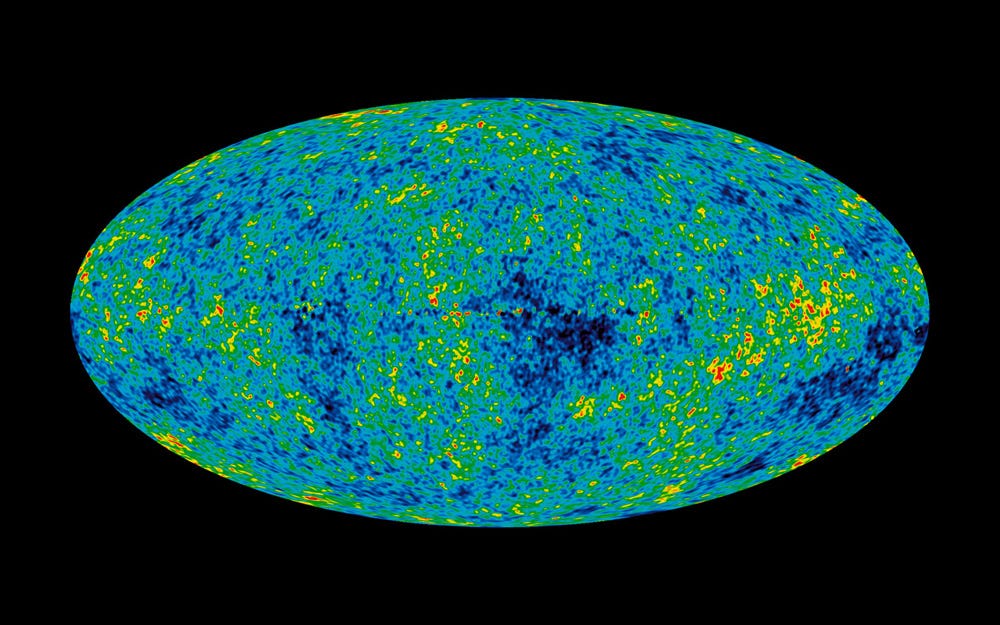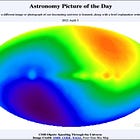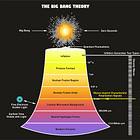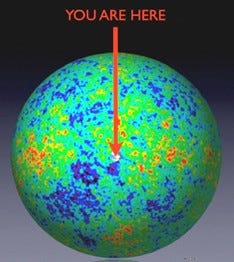Distant Events; Observations; A small universe; and was Einstein right about something?
The Einstotle did not believe in an inflationary, infinite universe. The data supports his view. A goal for the Einstein!

“How significant is this quadrupole-octopole alignment? As a simple definition of preferred axis, [it] denotes the spherical harmonic coefficients of the map in a rotated coordinate system….if the CMB is an isotropic Gaussian random field, then a chance alignment this good requires a 1-in-62 fluke.” (Max Tegmark, Angélica de Oliveira-Costa and Andrew Hamilton, “A high resolution foreground cleaned CMB map from WMAP,” Physical Rev. D, July 26, 2003, p. 14)
To translate the above, "Scientists have found that two specific patterns (four poles and eight poles within the cosmic background radiation), in the early universe's picture are lined up in a very unusual way. If our current understanding of the universe is correct, this alignment should be completely random. But the odds of it happening by chance are very low, maybe about 1 in 62 (or much lower in the author’s opinion). This suggests that there might be something about the universe we don't understand."
Einstein was right?
The above observation and interpretation indicate a far smaller universe than we are told. That is what they mean by ‘something about the universe that we don’t understand’. Distant events, WMAP, JWST, COBE and other telescopic and probe information, do not support the infinite universe model. Einstein was right when he originally believed, based on some basic Newtonian logic, that the universe was likely static and not infinite or expanding. One for Einstein!
The universe might ‘pulse’ in and out, and oscillate as a wave, but the data does not support the claim that there is an accelerating expansion and infinity. This contravenes the Relativity-Big Bang paradigm which demands homogeneity and expansion to infinity at astronomic speed:
“(data)…show significant anisotropy, the smallest value of Ωm being towards (l, b) = (253.9, 24.1), the largest in the opposite direction. This is close to the CMB dipole axis, but in the obverse sense. This is interpreted as meaning that the Universe is not spatially homogeneous on the largest scales, and is better represented at late times by a spherically symmetric model with a density enhancement at its centre.
I report here a test of isotropy based upon the angular-size/redshift relationship, using ultra-compact radio sources as standard measuring rods; these objects have angular diameters in the milliarcsecond (mas) range, and linear sizes of order several parsecs. In fact the test reveals significant anisotropy, a tentative interpretation of which is that the Universe is not spatially homogeneous on the largest scales, and is better represented at late times by a spherically symmetric model with a density enhancement at its centre. Antoniou & Perivolaropoulos (2010) have already looked at Union2 SnIa dataset in this context, which shows a similar anisotropy; my approach closely follows theirs.”1
To simplify the above, what the data is stating is that when we look at the distribution of matter and the size of radio sources across the universe, we see a pattern that isn't uniform. This means that the universe might not be the same in all directions on a large scale. Such a pattern supports a model where our planet is in a region with more matter at its center, rather than a perfectly even universe.
This indicates quite plainly that the universe is a spherical disc, flat, within a defined centre (our own solar system in fact) and anisotropic, all of which contradicts Relativity-Big Bang.
Hubble Flow Variance Confirms Non-Copernican Universe
The Copernican model might be valid, but it is always in need of proof which is very hard to collect. There is something called the ‘Hubble Flow Variance’, trotted out as ‘proof’ of the expanding universe and Copernicanism. The claim is tautological. The standard model of cosmology roughly defines the HVF as:
The allegedly observed expansion of the universe where galaxies recede from each other at speeds proportional to their distance (Newtonian mechanics here, nothing to do with Relativity). The recession is not uniform. Variance in this flow, arises from local gravitational influences. Velocities of galaxies are ‘pulled’ toward higher mass concentrations, like galaxy clusters, or pushed away from voids which contain less mass or are massless.
There are plenty of problems with the above. For starters, Redshifts have nothing to do with recession, or age. Galaxies are seen moving toward us, as well as away from us. Galaxies appear from ‘nowhere’ and also seem to disappear. The false assumptions behind the HVF include:
· -Dark Matter and Dark Energy (neither exists)
· -The accuracy of the Hubble Constant (greatly varies and is trending toward zero)
· -Redshifts ‘prove’ galaxial acceleration (wrong)
None of the above are valid and are redundantly assumed constants or parameters in their equations. Studies and data do not support HVF:
“We characterize the radial and angular variance of the Hubble flow in the composite sample of 4534 galaxies, on scales in which much of the flow is in the nonlinear regime. With no cosmological assumptions other than the existence of a suitably averaged linear Hubble law, we find with decisive Bayesian evidence (ln B > 5) that the Hubble constant averaged in independent spherical radial shells is closer to its asymptotic value when referred to the rest frame of the Local Group (LG), rather than the standard rest frame of the Cosmic Microwave Background (CMB).”2
What does the above mean?
Dipolar disorder
The ‘Local Group’ is us, our Earth. Big Bang advocates admit that the expansion of the universe can only be measured against the absolute that is this planet. It is not measured against cosmic microwave radiation (CMB). This is despite the fact that the Big Bang maintains that the Earth is moving through space, though the CMB is not! To the author this seems rather curious. We are told by Relativists and Bangers that the Earth is not an absolute. Yet they use our planet as the absolute (immobile) ‘Local Group’ (LG). Interesting.
“Further, if we map the angular Hubble flow variation in the LG rest frame, it is found to coincide with that of the residual CMB temperature dipole, with correlation coefficient −0.92. These results are difficult if not impossible to reconcile with the standard kinematic interpretation of the motion of the Local Group in response to the clustering dipole but are consistent with a foreground non-kinematic anisotropy in the distance-redshift relation of 0.5% on scales up to 65 h −1 Mpc.”3
In other words, it is very difficult to align real data with the Copernican Principle or the idea that we the ‘Local Group’, inhabit no special place in the universe, i.e., the center. The data is saying the opposite.
“Ever since the first bounds were placed on the anisotropy of the CMB in the mid-1960s it has been assumed that the dipole anisotropy represents a measurement of our motion with respect to our surface of average homogeneity. Our results clearly show, however, that for spherical (monopole) averages the Hubble flow is closer to being uniform in the frame of the LG or LS, rather than the frame indicated by treating the CMB dipole as being entirely due to a boost. This is completely unexpected in the standard framework, since the cosmic rest frame and the frame of minimum Hubble flow variance should be one and the same.”4
By ‘dipole anisotropy’, the authors mean an observed pattern where the CMB appears slightly hotter in one direction and slightly colder in the opposite direction. This temperature difference creates a ‘dipole’ pattern, or 2 opposing poles, across the sky, one slightly hotter, one slightly cooler. This anisotropy is the largest within the CMB and is referenced to explain the Earth’s motion.5
The data is stating that Big Bang cosmology can no longer claim that the CMB dipole is created by the movement of the Local Group [us] through the CMB. The dipole is intrinsic, not an illusion. Since the dipole is oriented around the Earth’s equator, it strongly suggests that the whole universe is centered on the Earth. Anathema! Worse, the above Relativists are observing with their own data that we the Local Group, are not moving with respect to both the CMB and the Hubble flow through it! More anathema!
The standard ‘Science’ explanation for this is roundly confusing:
· The physical phenomenon (our motion causing a Doppler shift) is the actual physical cause of the dipole. But this is not what the data says as quoted above.
· The way we represent that phenomenon on a map (using coordinate systems) is where the apparent alignment with the equator arises.6
Again, this explanation appears tautological. To wit: I assume the Earth is moving. I assume the Doppler shift indicates ‘relative’ movement. I assume this causes the dipole-effect. I then assume that the coordinate system of this effect, on our equator, is of no importance. We leave it up to the reader to decide if this explanation is sensible or contains anything resembling logic and science.
Bottom Line: Louis XVI’s Hall of Mirrors?
Is the universe a larger and circular version of Louis’ elaborate Hall of Mirrors? Was Einstein actually right about something?
WMAP results suggest that the universe is not only small, but that space wraps back on itself in a bizarre way. In essence the universe would have a ‘wrap-around effect’ producing multiple images of everything inside. We might be viewing the same galaxies innumerable times. This would eliminate the complexities, infinities and ad hoc explanations of Relativity and the Big Bang.7 It also destroys the Copernican principles and recovers humanity’s importance in the cosmos.
It should be stated that even with the ‘standard model’ of cosmology, the equations ‘allow this to happen’. Keep in mind when you ‘search google’ or use AI, the default comparative model within the code and data is that the Big Bang and Relativity are proven. This is what passes for ‘The Science’.
Einstotle’s own equations allow for a small-wrap around universe.8 Einstein might actually have been right about something, though in general of course, we all know that Relativity is junk science. But let’s be generous and give some credit to the little magician.
All hail.
==
1“Ultra-compact radio sources and the isotropy and homogeneity of the Universe,” J. C. Jackson, July 3, 2012, arXiv:1207
2“Hubble flow variance and the cosmic rest frame,” David Wiltshire, et al, October 1, 2013, arXiv:1201.5371v4, abstract.
3 “Hubble flow variance and the cosmic rest frame,” David Wiltshire, et al, October 1, 2013, arXiv:1201.5371v4, abstract
4 Ibid
5"The Cosmic Microwave Background Dipole Anisotropy" by G. F. Smoot et al. (Astrophysical Journal, 1977).
6 https://academic.oup.com/mnras/article/453/2/2058/1138529
7Hazel Muir, “Does the Universe Go On Forever,” New Scientist, October 11, 2003, p. 6.
8 http://space.mit.edu/home/tegmark/wmap.html, M. Tegmark and G. Efstathiou, Monthly Notices of the Royal Astronomical Society, 281, 1297, 1996








